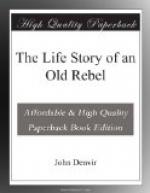It was the Sadlier-Keogh treason, their selling themselves to the Government after the most solemn promises to the contrary, and the way in which their conduct had been condoned by so many of the hierarchy, clergy and people of Ireland, that caused Gavan Duffy to lose heart for the time, and to declare, as he left the country, in memorable words—“that there was no more hope for Ireland than for a corpse on the dissecting table.”
But, as I learned from his own lips on his return to this country, he never lost sight of the National movement while in Australia, where he became first Minister of the Crown in a self-governing colony; and, on his return, his old hope for the success of our Cause had, he assured me, revived.
Charles Gavan Duffy having sailed for Australia on the 6th of November, 1855, John Cashel Hoey succeeded him as editor of the “Nation,” he having, as one of his colleagues, Alexander Martin Sullivan, who afterwards became sole proprietor and responsible editor.
“A.M.” Sullivan, as he was always called, was an upright man, who had a very clear conception of his own policy in Irish matters. He frankly accepted the British constitution, and worked inside those lines. To me, when my country was concerned, the British constitution (with the making of which neither I nor my people had ever had anything to do) was a matter of very little moment. Any work for Ireland that commended itself to my conscience and was practicable was good enough. Nevertheless, it will ever be to me a source of pride that, from the moment when we first knew each other to the hour of his death, we were the closest friends.
In connexion with the “Papal aggression” mania, Cardinal Wiseman was the central figure against whom the storm of bigotry was chiefly directed. I remember with pleasure that I took part in the reception given to him in Liverpool by Father Nugent and the students of the Liverpool Catholic Institute, by whom the Cardinal’s fine play of “The Hidden Gem” was performed in the Hall of the Institute during his stay in town. The bringing of the Cardinal to Liverpool was only one of the many occasions when the good Father was the medium through whom, from time to time, a number of distinguished Catholics and Irishmen were brought into intimate contact with their co-religionists and fellow-countrymen in the town for the advancement of some worthy object connected with creed or nationality—most frequently with both.
I have described the St. Patrick’s Day annual processions in Liverpool. Notwithstanding some grand features in connection with them, they were, unfortunately, sometimes the occasion of rioting and intemperance. Father Nugent was of Irish parentage and sympathies, and possessed of great zeal, capacity, energy and eloquence. He determined to make a new departure in celebrating the national anniversary, for though the processions were magnificent displays, and it was not the fault of their promoters if ever




